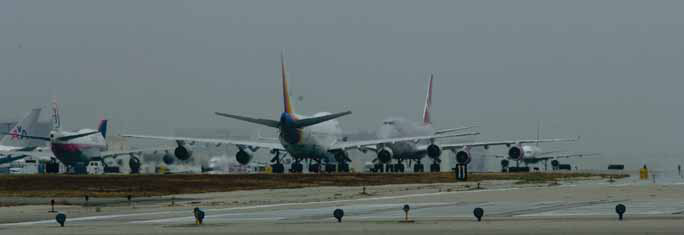 |
|
| INSTRUMENT PROCEDURES HANDBOOK |
|
NATIONAL AIRSPACE SYSTEM PLANS FAA planners’ efforts to devise a broad strategy to address capacity issues resulted in the Operational Evolution Plan (OEP)—the FAA’s commitment to meet the air transportation needs of the U.S. for the next ten years. To wage a coordinated strategy, OEP executives met with representatives from the entire aviation community— including airlines, airports, aircraft manufacturers, service providers, pilots, controllers, and passengers. They agreed on four core problem areas:
An important contributor to FAA plans is the Performance-Based Operations Aviation Rulemaking Committee (PARC). The objectives and scope of PARC are to provide a forum for the U.S. aviation community to discuss and resolve issues, provide direction for U.S. flight operations criteria, and produce U.S. consensus positions for global harmonization. The general goal of the committee is to develop a means to implement improvements in operations that address safety, capacity, and efficiency objectives, as tasked, that are consistent with international implementation. This committee provides a forum for the FAA, other government entities, and affected members of the aviation community to discuss issues and to develop resolutions and processes to facilitate the evolution of safe and efficient operations. Current efforts associated with NAS modernization come with the realization that all phases must be integrated. The evolution to an updated NAS must be well orchestrated and balanced with the resources available. Current plans for NAS modernization focus on three key categories:
It is crucial that our NAS equipment is protected, as lost radar, navigation signals, or communications capabilities can slow the flow of aircraft to a busy city, which in turn, could cause delays throughout the entire region, and possibly, the whole country. The second category for modernization activities focuses on upgrades concerning safety. Although we cannot control the weather, it has a big impact on the NAS. Fog in San Francisco, snow in Denver, thunderstorms in Kansas, wind in Chicago; all of these reduce the safety and capacity of the NAS. Nevertheless, great strides are being made in our ability to predict the weather. Controllers are receiving better information about winds and storms, and pilots are receiving better information both before they take off and in flight—all of which makes flying safer. [Figure 1-4] Another cornerstone of the FAA’s future is improved navigational information available in the cockpit. The Wide Area Augmentation System (WAAS) initially became operational for aviation use on July 10, 2003. It improves conventional GPS signal accuracy by an order of magnitude, from about 20 meters to 2 meters or less. Moreover, the local area augmentation system (LAAS) is being developed to provide even better accuracy than GPS with WAAS. LAAS will provide localized service for final approaches in poor weather conditions at major airports. This additional navigational accuracy will be available in the cockpit and will be used for other system enhancements. More information about WAAS and LAAS is contained in Chapters 5 and 6. The Automatic Dependent Surveillance (ADS) system, currently being developed by the FAA and several airlines, enables the aircraft to automatically transmit its location to various receivers. This broadcast mode, commonly referred to as ADS-B, is a signal that can be received by other properly equipped aircraft and ground based transceivers, which in turn feed the automation system accurate aircraft position information. This more accurate information will be used to improve the efficiency of the system—the third category of modernization goals.
Other key efficiency improvements are found in the deployment of new tools designed to assist the controller. For example, most commercial aircraft already have equipment to send their GPS positions automatically to receiver stations over the ocean. This key enhancement is necessary for all aircraft operating in oceanic airspace and allows more efficient use of airspace. Another move is toward improving text and graphical message exchange, which is the ultimate goal of the Controller Pilot Data Link Communications (CPDLC) Program. In the en route domain, the Display System Replacement (DSR), along with the Host/Oceanic Computer System Replacement (HOCSR) and Eunomia projects, are the platforms and infrastructure for the future. These provide new displays to the controllers, upgrade the computers to accept future tools, and provide modern surveillance and flight data processing capabilities. For CPDLC to work effectively, it must be integrated with the en route controller’s workstation. |
